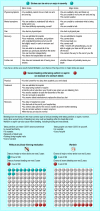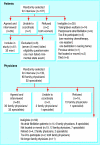Differences between perspectives of physicians and patients on anticoagulation in patients with atrial fibrillation: observational study
- PMID: 11719412
- PMCID: PMC59994
- DOI: 10.1136/bmj.323.7323.1218
Differences between perspectives of physicians and patients on anticoagulation in patients with atrial fibrillation: observational study
Abstract
Objective: To determine and compare physicians' and patients' thresholds for how much reduction in risk of stroke is necessary and how much risk of excess bleeding is acceptable with antithrombotic treatment in people with atrial fibrillation.
Design: Prospective observational study.
Setting: Tertiary and peripheral referral centres in Nova Scotia, Canada.
Participants: 63 physicians who were treating patients with atrial fibrillation and 61 patients at high risk for atrial fibrillation.
Main outcome measures: Participants underwent a face to face interview with a probability trade-off tool. Thresholds were determined for the minimum reduction in risk of stroke necessary and the maximum increase in risk of excess bleeding acceptable for treatment with aspirin and warfarin in people with atrial fibrillation.
Results: The minimum number of strokes that needed to be prevented in 100 patients over two years for warfarin to be justified was significantly lower for patients than for physicians (1.8 (SD 1.9) v 2.5 (1.6), P=0.009), whereas for aspirin there was no difference between patients and physicians (1.3 (1.3) v 1.6 (1.5), P=0.29). The maximum number of excess bleeds acceptable in 100 patients over two years for use of warfarin and aspirin was significantly higher for patients than for physicians (warfarin 17.4 (7.1) v 10.3 (6.1); aspirin 14.7 (8.5) v 6.7 (6.2); P<0.001 for both comparisons).
Conclusions: Patients at high risk for atrial fibrillation placed more value on the avoidance of stroke and less value on the avoidance of bleeding than did physicians who treat patients with atrial fibrillation. The views of the individual patient should be considered when decisions are being made about antithrombotic treatment for people with atrial fibrillation.
Figures
References
-
- Cuddy TE, Connolly SJ. Atrial fibrillation and atrial flutter. Can J Cardiol. 1996;(12 suppl A):9–11. - PubMed
-
- Wolf PA, Abbott RD, Kannel WB. Atrial fibrillation as an independent risk factor for stroke: the Framingham study. Stroke. 1991;22:983–988. - PubMed
-
- Atrial Fibrillation Investigators. Risk factors for stroke and efficacy of antithrombotic therapy in atrial fibrillation. Analysis of pooled data from five randomized controlled trials. Arch Intern Med. 1994;154:1449–1457. - PubMed
-
- Atrial Fibrillation Investigators. The efficacy of aspirin in patients with atrial fibrillation. Analysis of pooled data from 3 randomized trials. Arch Intern Med. 1997;157:1237–1240. - PubMed
Publication types
MeSH terms
Substances
LinkOut - more resources
Full Text Sources
Medical






